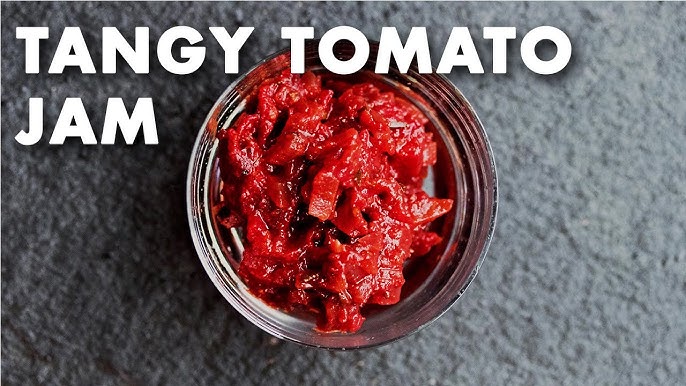Tomato Jam Recipe: Tomato jam is one of those delightful culinary creations that walks the fine line between sweet and savory. Imagine a spread that’s rich, tangy, slightly sweet, and absolutely bursting with tomato flavor. Unlike traditional fruit jams, tomato jam offers a unique complexity, thanks to the natural umami found in tomatoes. It’s more than just a condiment—it’s a flavor bomb that elevates everything from toast and cheese boards to burgers and roasted meats.
Why Make Tomato Jam at Home?
Why settle for store-bought when you can whip up a jar of this sweet-savory delight in your own kitchen? Homemade tomato jam is fresher, more flavorful, and completely customizable. You get to choose the level of sweetness, spice, and even the texture. Plus, making it yourself means fewer preservatives and more control over what goes into your food. Whether you’re a seasoned cook or just starting out, tomato jam is an easy, rewarding recipe to master.
Ingredients You’ll Need
Fresh and Simple Ingredients List
The beauty of tomato jam lies in its simplicity. You don’t need exotic ingredients or hard-to-find spices—just a handful of pantry staples and some ripe tomatoes. Here’s what you’ll need:
- 2 pounds of ripe tomatoes (Roma or plum work great)
- 1 cup granulated sugar (you can use brown sugar for deeper flavor)
- 2 tablespoons lemon juice (for acidity and preservation)
- 1 teaspoon grated fresh ginger (optional, for warmth)
- ½ teaspoon ground cinnamon
- ¼ teaspoon ground cloves
- ¼ teaspoon red chili flakes (optional, for heat)
- Salt to taste
Feel free to experiment! You can add other ingredients like garlic, balsamic vinegar, or even fresh herbs like basil or thyme to make the jam your own.
Choosing the Right Tomatoes
Not all tomatoes are created equal, especially when it comes to making jam. The best tomatoes for this recipe are meaty and low in water content, like Roma or plum tomatoes. They have fewer seeds and more flesh, which means you’ll get a richer, thicker jam. If you’re using juicy heirlooms or cherry tomatoes, you may need to cook them longer to reduce the water content and achieve the desired consistency.
Also, make sure your tomatoes are fully ripe. Overripe tomatoes may not look perfect, but they’re often the most flavorful and ideal for jam-making.
Preparing for the Recipe
Kitchen Tools and Utensils
Before you start chopping and stirring, gather all your kitchen tools. You’ll need:
- A large, heavy-bottomed pot or Dutch oven
- A sharp knife and cutting board
- A wooden spoon or heat-safe spatula
- Measuring cups and spoons
- A food processor or immersion blender (optional, for smoother texture)
- Clean glass jars with lids for storing
Using a heavy-bottomed pot is especially important—it helps prevent the jam from burning as it simmers and thickens.
How to Sterilize Jars for Storing Jam
Storing your tomato jam in sterilized jars isn’t just good practice—it’s essential for food safety and shelf life. Here’s a quick guide to sterilize your jars:
- Wash jars and lids in hot soapy water.
- Rinse thoroughly and place them (upright) on a baking sheet.
- Put the tray in a preheated oven at 275°F (135°C) for 10 minutes.
- Alternatively, you can boil the jars in a large pot of water for 10 minutes.
- Let them dry completely before filling with hot jam.
Never pour hot jam into cold jars—it can cause them to crack. Let the jars cool slightly or pre-warm them before use.
Step-by-Step Tomato Jam Recipe
Step 1: Washing and Chopping Tomatoes
Start by giving your tomatoes a good rinse under cold water. Remove any stems and cut out any blemished spots. Then, roughly chop them into small chunks. You don’t need to be precise—everything will break down as it cooks.
If you prefer a smoother jam, you can remove the skins by blanching the tomatoes in boiling water for 30 seconds, then peeling them. But honestly, the skins break down well during cooking and add a rustic texture, so skipping this step is perfectly fine.
Step 2: Cooking the Tomatoes
Now the fun begins! Place your chopped tomatoes in the pot and set it over medium heat. Stir in the sugar, lemon juice, and all your chosen spices. As the mixture heats up, the sugar will dissolve, and the tomatoes will begin to release their juices.
Bring everything to a gentle boil, then reduce the heat to low and let it simmer. Stir occasionally to prevent sticking or burning, especially as the jam begins to thicken.
Step 3: Adding Flavors and Spices
Once your tomato mixture has softened and begun to bubble gently, it’s time to add your flavor-enhancing ingredients. This is where the real magic happens.
Add in the ginger, cinnamon, cloves, red chili flakes (if using), and a pinch of salt. The ginger adds warmth, the cinnamon and cloves bring a touch of sweetness and spice, and the chili flakes give the jam a little kick—just enough to wake up your taste buds without overwhelming the other flavors.
At this stage, your kitchen will start to smell absolutely divine. The mix of simmering tomatoes with aromatic spices is a sensory treat, and it only gets better as it cooks. Stir the pot well to ensure all the ingredients are evenly distributed, and then let it continue to simmer. You can taste and adjust the seasoning here—more sugar if it’s too tart, a splash more lemon juice if it needs acidity, or extra chili if you like it hot.
Step 4: Simmering Until Thickened
Patience is key here. Tomato jam needs to simmer slowly for 45 minutes to an hour, sometimes even longer depending on how juicy your tomatoes are. The goal is to reduce the liquid content and achieve a thick, jam-like consistency. You’ll know it’s done when the mixture is glossy, sticks to your spoon, and doesn’t run when spread on a plate.
Be sure to stir regularly, especially towards the end of cooking. The sugars can easily stick to the bottom of the pot and burn, which would ruin the batch. If you prefer a smoother texture, you can use an immersion blender right in the pot, or let it cool slightly and blend in batches in a food processor. Just don’t overdo it—you want a bit of texture in your jam.
You can test the thickness by placing a small spoonful on a chilled plate. Let it sit for a minute, then drag your finger through it. If it holds its shape and doesn’t run back together, it’s ready.
Step 5: Storing Your Jam
Once your jam has reached the perfect consistency, remove it from the heat. While it’s still hot, carefully ladle it into your sterilized jars. Leave about ¼ inch of space at the top of each jar. Wipe the rims clean with a damp cloth and seal tightly with the lids.
Let the jars cool to room temperature, then store them in the refrigerator if you plan to use them within a few weeks. For longer storage, you can process the jars in a hot water bath for 10 minutes to create a vacuum seal. Properly sealed, your tomato jam will keep in a cool, dark place for up to a year.
Label your jars with the date and ingredients—it’s always a good idea, especially if you like to experiment with different variations.
Tips and Variations
Sweet vs Savory Tomato Jam
Tomato jam can lean sweet, savory, or somewhere in between—it all depends on your taste and how you plan to use it. For a sweeter jam, increase the sugar and perhaps add a hint of vanilla or a splash of fruit juice like orange or apple. For a more savory profile, reduce the sugar slightly and add ingredients like garlic, balsamic vinegar, smoked paprika, or even finely chopped onions.
Balancing flavors is key. A good tomato jam should be tangy, slightly sweet, and packed with depth. Don’t be afraid to tweak the recipe to find your perfect blend.
Adding Herbs and Spices for a Twist
Want to elevate your jam even further? Consider adding:
- Fresh basil or thyme for a herby, garden-fresh touch.
- Crushed coriander seeds for a citrusy note.
- Cumin or fennel seeds for earthy undertones.
- Smoked paprika for a deep, smoky kick.
Each addition changes the character of your jam slightly, making it feel like a brand-new recipe every time. This is what makes tomato jam so addictive—its versatility is unmatched.
Serving Suggestions
Perfect Pairings with Tomato Jam
Tomato jam is an all-star condiment. Spread it on a crusty baguette with goat cheese or brie, and you’ve got a party-worthy appetizer. Add a dollop to your breakfast toast for a gourmet twist. Slather it on sandwiches, especially grilled cheese or turkey, for an instant upgrade.
It also pairs incredibly well with:
- Cheese boards – It complements everything from sharp cheddar to creamy camembert.
- Roasted meats – A spoonful on grilled chicken or pork tenderloin adds depth and moisture.
- Egg dishes – Serve alongside scrambled eggs or omelets for a burst of flavor.
- Burgers – Swap out ketchup for tomato jam and take your burger game to the next level.
Tomato Jam in Everyday Dishes
You’d be surprised how often you’ll reach for this jam once you have it in your fridge. Stir it into pasta sauces for extra richness. Mix it with mayonnaise or Greek yogurt for a custom dipping sauce. Add it to tacos or wraps for a sweet-savory bite. Even a teaspoon stirred into soup can transform the flavor.
Think of tomato jam as your secret weapon—it adds instant complexity and makes simple meals feel a little more special.
Storage and Shelf Life
How Long Does Tomato Jam Last?
If stored properly, your homemade tomato jam can last:
- Refrigerated (unprocessed jars): 2 to 3 weeks
- Canned (water bath method): Up to 1 year
- Frozen (in airtight containers): 6 months
Just make sure to always use clean utensils when scooping from the jar to avoid contamination.
Best Storage Practices
For best results:
- Store in small jars to reduce the risk of spoilage after opening.
- Label each jar with the date.
- Keep refrigerated once opened.
- If freezing, leave space in the container for expansion and avoid glass jars unless freezer-safe.
FAQs about Tomato Jam Recipe
1. What is tomato jam made of?
Tomato jam is typically made with ripe tomatoes, sugar, vinegar, and a mix of spices like ginger, cloves, cinnamon, or chili flakes. It balances sweet, tangy, and savory flavors.
2. How long does homemade tomato jam last?
Stored in an airtight jar in the fridge, homemade tomato jam can last up to 3 weeks. For longer shelf life, consider canning it properly.
3. What’s the best type of tomato for making tomato jam?
Roma or plum tomatoes are ideal because they’re meaty and have fewer seeds, making them perfect for thick, flavorful jam.
4. Can I use cherry tomatoes for tomato jam?
Yes! Cherry tomatoes work beautifully and bring a slightly sweeter taste. Just be prepared for a thinner consistency unless you cook it down longer.
5. Is tomato jam spicy?
It can be! Some recipes add red pepper flakes or jalapeños for a spicy kick, but you can totally skip the heat if you prefer a milder version.
6. What can I eat with tomato jam?
Think beyond toast—tomato jam pairs great with cheese boards, grilled meats, burgers, eggs, and even roasted veggies.
7. Can I freeze tomato jam?
Absolutely. Freeze it in small, airtight containers for up to 3 months. Just thaw in the fridge before using.
8. Is tomato jam the same as ketchup?
Nope. While both are tomato-based, tomato jam is thicker, chunkier, and more complex in flavor with a jam-like consistency and less vinegar than ketchup.
9. Can I make tomato jam without sugar?
Yes, you can substitute with honey, maple syrup, or a sugar alternative—but the texture and shelf life might change a bit.
10. How do I know when my tomato jam is done cooking?
It should be thick, glossy, and hold its shape on a spoon. Run a finger through a spoonful on a cold plate—if the line stays, it’s ready.
Conclusion
Tomato jam is one of those humble recipes that surprises you with how incredibly delicious it is. With just a handful of ingredients and a little time, you can create a condiment that’s bold, versatile, and absolutely packed with flavor. Whether you’re a home cook looking to try something new or a seasoned kitchen pro, this jam belongs in your culinary toolkit.
Make a batch today and you’ll be finding excuses to slather it on everything in sight.



